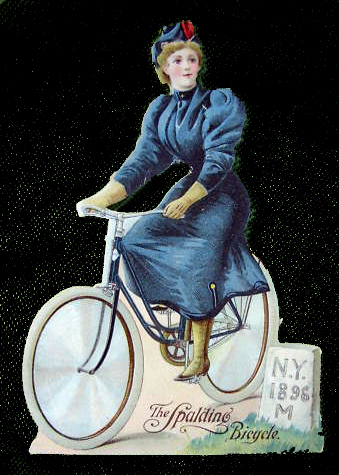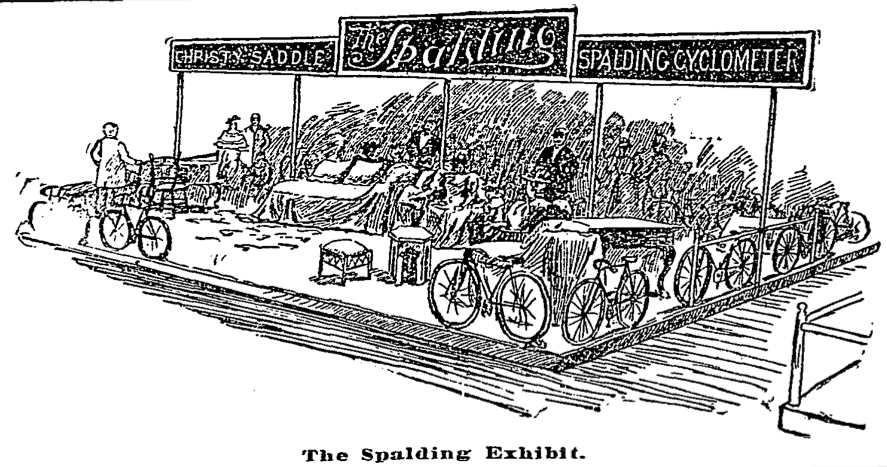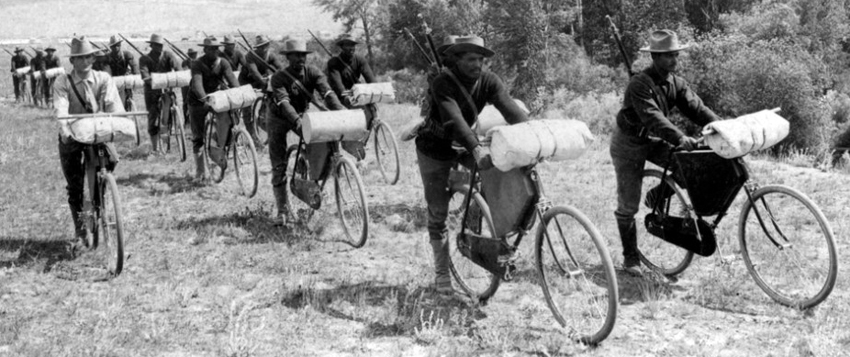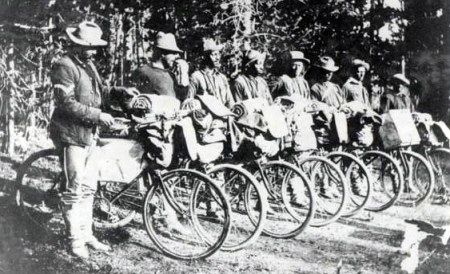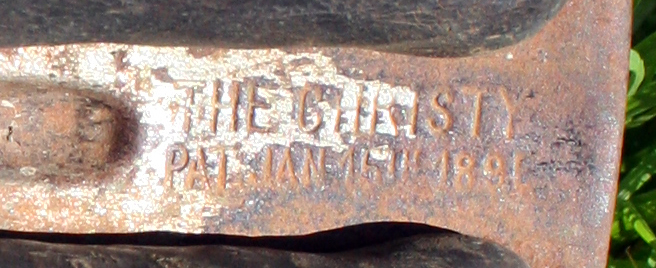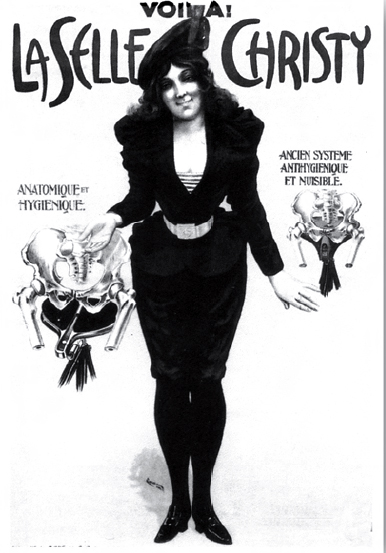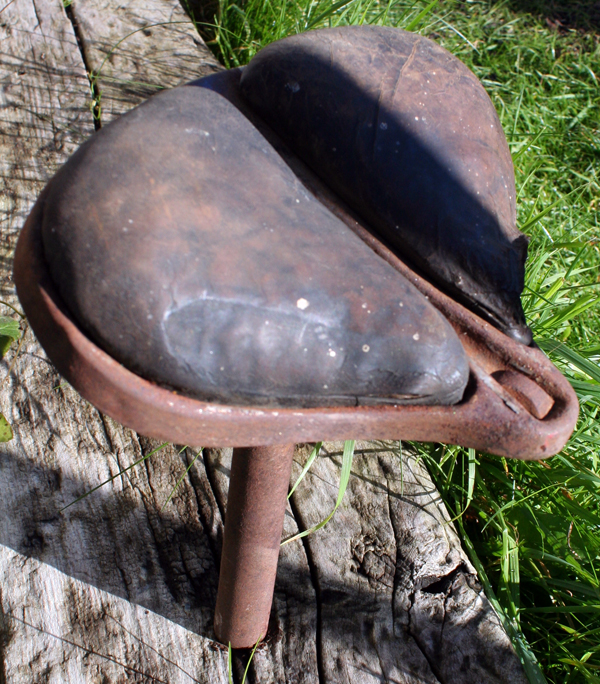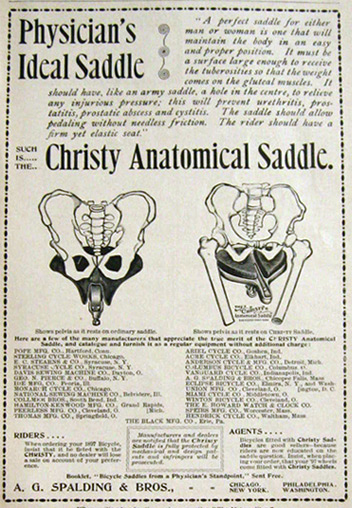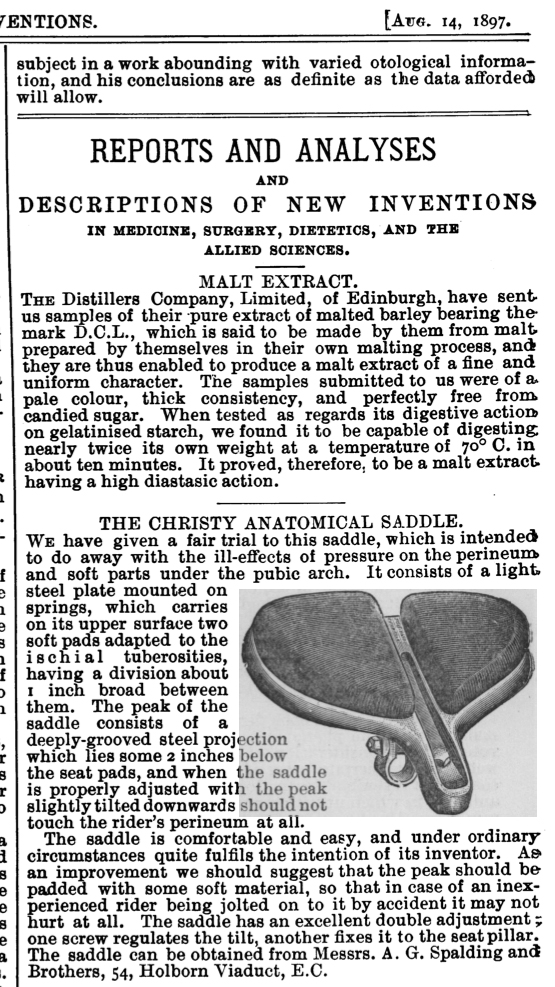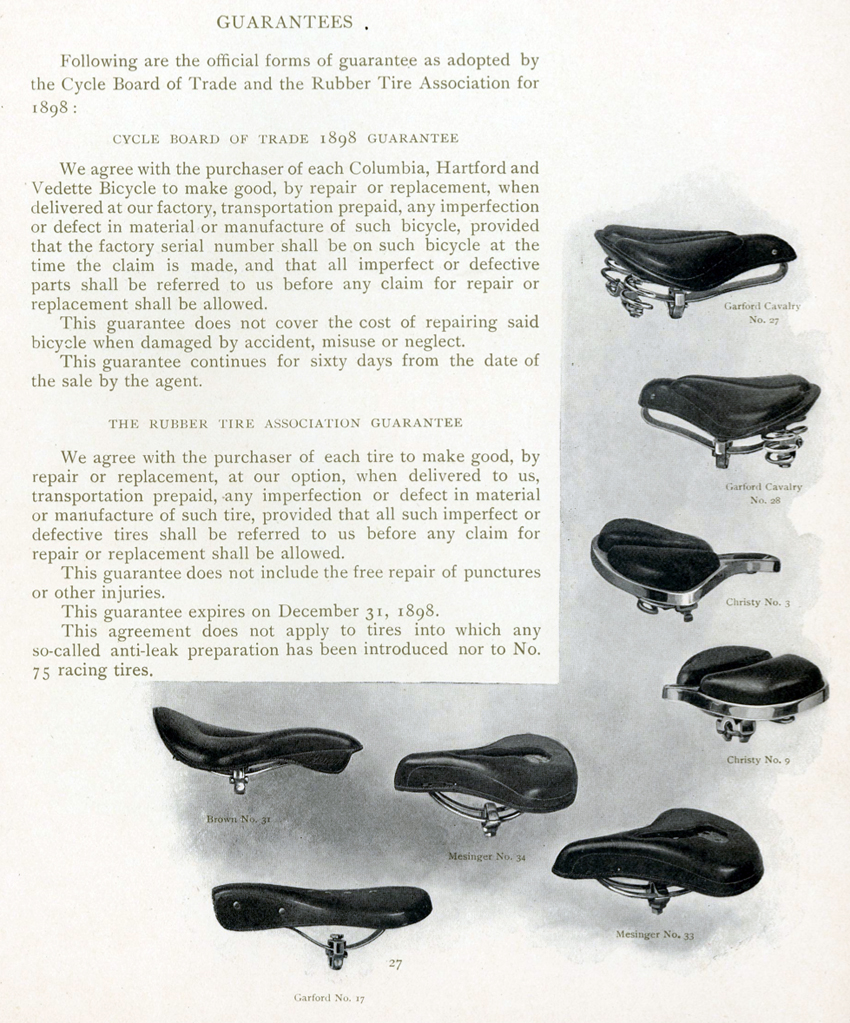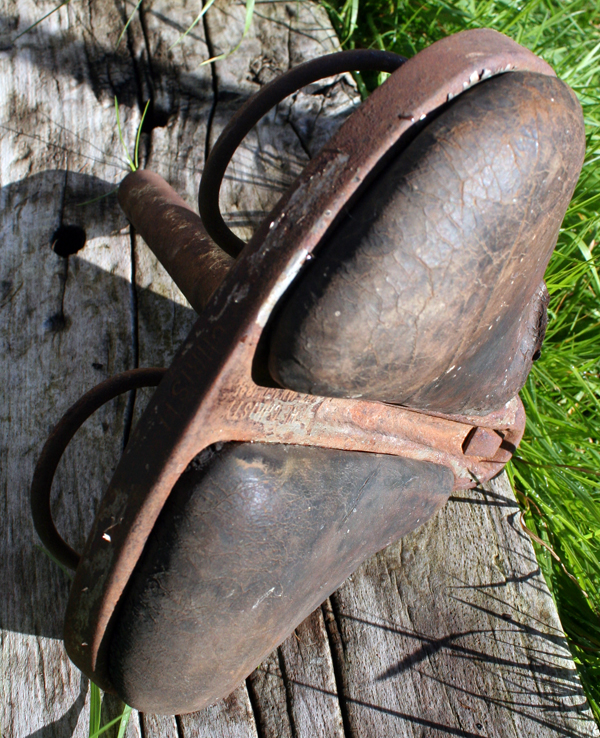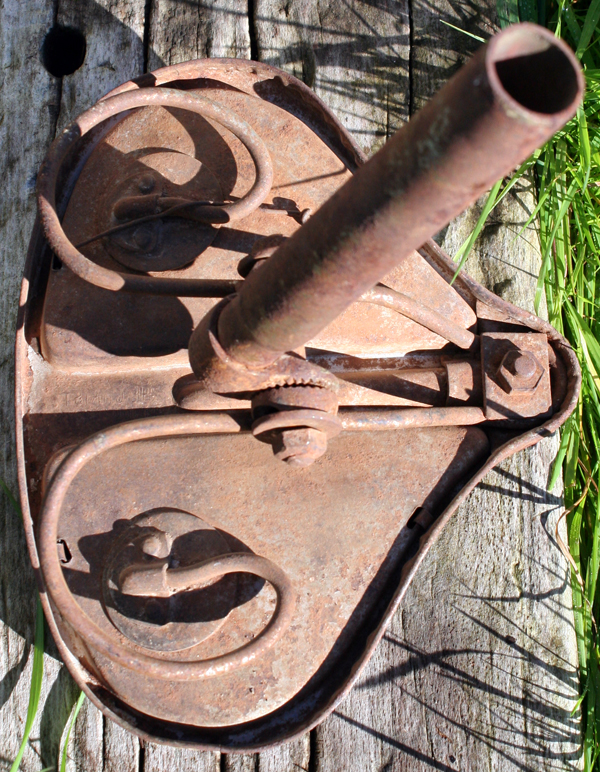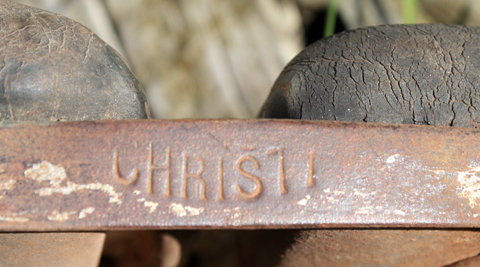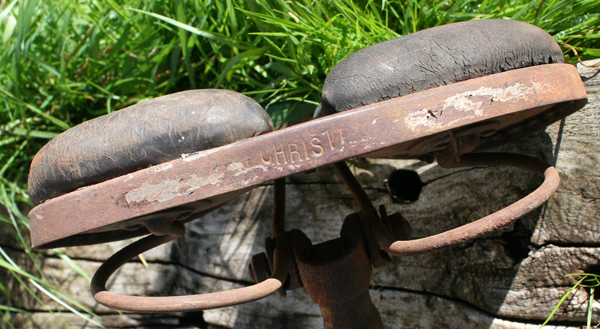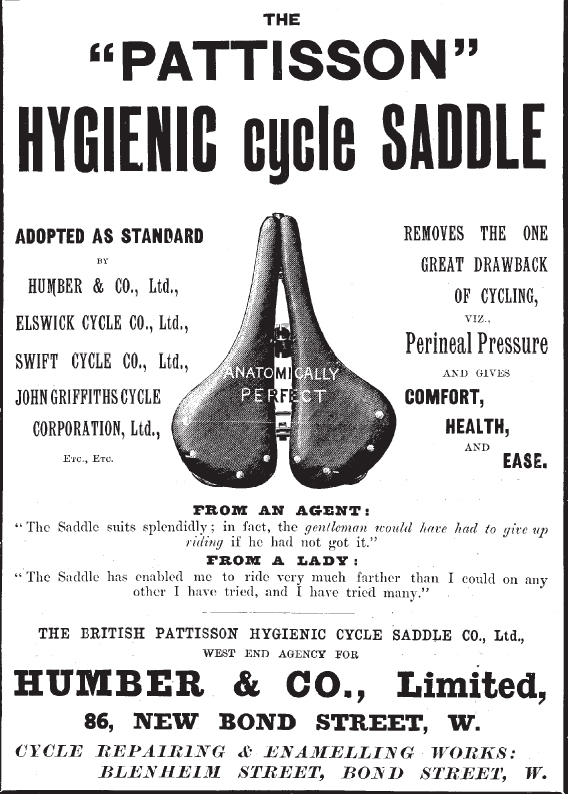1897 Spalding Military Bicycle & Christy Saddle
A.G. Spalding was a sporting goods company from Chicopee Falls, Massachusetts and, in the mid-1890s, they were America’s leading bicycle manufacturer. They marketed the renowned Christy Anatomical saddle, as well as other cycle accessories.
In the book Iron Riders: Story of the 1890s Fort Missoula Buffalo Soldiers Bicycle Corps, George Niels Sorensen reveals the interesting story of a racially-segregated unit comprised of black men commanded by white officers, who undertook a 1900-miles journey across America to test the practicality of the military use of bicycles.
These military machines, the first to be commissioned by the US Army, were made by Spalding. A rigorous military test of Spalding bicycles would have been an unrepeatable public relations opportunity for the company, and they gladly donated the bicycles to the government. The Spalding machines were state of the art for the year: the steel frames and rims (with Goodrich rubber tyres) made them strong, but they were also heavy and cumbersome, each weighing around 25lbs.
25th INFANTRY BUFFALO SOLDIERS
The trip has proved beyond peradventure my contention that the bicycle has a place in modern warfare. In every kind of weather, over all sorts of roads, we averaged fifty miles a day. At the end of the journey we are all in good physical condition. Seventeen tires and half a dozen frames is the sum of our damage. The practical result of the trip shows that an Army Bicycle Corps can travel twice as fast as cavalry or infantry under any conditions, and at one third the cost and effort.
from Iron Riders: Story of the 1890s Fort Missoula Buffalo Soldiers Bicycle Corps by George Niels Sorensen (Pictorial Histories Publishing Co, 2000)
The widespread popularity of the bicycle worldwide caught the attention of military leaders in the United States during the late 1800s. Major General Nelson A. Miles, as Army Commander-in-Chief, expressed his interest by recommending that one full regiment be equipped with bicycles in 1892, and that existing troops at different posts around the country use bicycles to obtain a thorough knowledge of their own country, especially the topographical features, conditions of the roads, sources of supplies, and all information of military importance.
On May 12, 1896, Fort Missoula’s 2nd Lieutenant James A. Moss received permission to organize the 25th Infantry Bicycle Corps, the first of its kind in the country. Moss, a native of Louisiana and a West Point graduate, was an avid cyclist who set out to thoroughly test the practicality of the bicycle for military purposes in mountainous country.
Moss contacted the A. G. Spalding Company, who agreed to provide military bicycles co-designed by Moss at no cost. The Corps, consisting of eight black enlisted men, soon was riding in formation, drilling, scaling fences up to nine-feet high, fording streams, and pedaling 40 miles a day. Each bicycle carried a knapsack, blanket roll, and a shelter half strapped to the handlebar. A hard leather frame case fit into the diamond of each bicycle and a drinking cup was kept in a cloth sack under the seat. Each rider carried a rifle (first slung over the back, later strapped to the horizontal bar) and 50 rounds of ammunition.
The Spalding military bicycles were furnished with steel rims, tandem spokes, extra-heavy side-forks and crowns, gear cases, luggage carriers, frame cases, brakes, and Christy saddles. They were geared to 68 inches and weighed 32 pounds. The average weight of the bicycles, packed, was about 59 pounds.
Training trips consisted of a series of rides of increasing lengths, including a trek to Lake McDonald in the Mission Mountains. In August 1896, Lieutenant Moss was ready for a major expedition: a trip from Fort Missoula to Yellowstone National Park and back – 800miles in all. The Bicycle Corps left Missoula on August 15. Moss kept a detailed log of each day’s progress, noting the types of grade, road conditions, and weather that the Corps encountered along the way. The Corps arrived in Yellowstone on August 24, 1896.
Pleased by the success of his Yellowstone trip, Lieutenant Moss wanted to test the Bicycle Corps on a longer route that would take in both low and high altitudes, wet and dry climates, and a variety of road conditions. He received permission to take his Bicycle Corps from Fort Missoula to St. Louis, Missouri, 1,900 miles away!
The Bicycle Corps left Missoula on June 14, 1897. Accompanying Moss as second-in-command was a fellow white officer, Assistant Surgeon James M. Kennedy. A newspaper correspondent, Edward “Eddie” H. Boos, also came along to file periodic dispatches along the route to the Daily Missoulian and the St. Louis papers. The twenty black enlisted men who made up the rest of the command were divided into two squads headed by Lance Corporals William Haynes and Abram Martin. Sergeant Mingo Sanders was Acting First Sergeant of the Corps.
Food for the trip consisted of the standard military field rations; Flour, baking powder, salt, pepper, dry beans, coffee, sugar, bacon, canned beef, and baked beans. Moss had arranged with the Quartermaster’s Department to have rations sent ahead and placed at 100-mile intervals along the route. The Corps carried only a two-day supply of rations as incentive to travel the scheduled 50 miles a day.
The trip to St. Louis was an ordeal from the very beginning. In describing the 41-day journey, Moss reported that: The bicycle, as a machine for military purpsoes, was most thoroughly tested under all possible conditions, except that of being under actual fire. The Corps went through a veritable campaign, suffering from thirst, hunger, the ill effects of alkali water, cold, heat and loss of sleep. A number of times we went into camp wet, muddy, hungry and tired …. Much of the time the roads were so bad that the Corps had to dismount and push their wheels along railroad tracks.
Despite the hardships, the 25th Infantry Bicycle corps was greeted triumphantly at each town along the route and upon its arrival in St. Louis on July 24. Moss intended to ride from St. Louis to Minneapolis to test the Bicycle Corps on more improved roads and then travel by train back to Missoula. However, General Miles was out of the country and permission was denied. On August 19, 1897, the men of the Bicycle Corps returned to Missoula by rail and the bicycles were shipped back to Spalding Company.
Lieutenant Moss requested permission on February 7, 1898, to organize another Bicycle Corps for the purpose of making a trip from Fort Missoula to San Francisco. Moss’ commanding officer, Colonel Andrew S. Burt, endorsed the proposal and suggested that the trip would call favorable attention to “colored soldiers” as they passed through the country. By this time, however, war with Spain was imminent and further bicycle tests were deemed unnecessary. The trip to San Francisco was not approved.
Trip Statistics:
Duration of trip: June 14 – July 24, 1897, 41 days.
Distance traveled: 1900.2 miles in 34 days of actual travel. An average of 55.9 miles per day and 6.3 miles per hour.
Delays: the command was delayed a total of seven days for the following reasons:
13 hours repairing bicycles
4 7/60 hours fixing tires
117 hours for lunch
71 1/3 hours for other causes.
The heaviest soldier, stripped, weighed 177 pounds; and the lightest 125 1⁄2 pounds; the average weight being 148 1⁄2 pounds.
The oldest man was 39 years old, the youngest 24 years; the average age was 27.
The Buffalo Soldiers information with thanks to Fort Missoula Museum – http://www.fortmissoulamuseum.org/blackbicyclecorps.php
******
Though there are a few old American bicycles in my collection, I don’t have a Spalding. However, I do have a saddle. And though I didn’t realize it when I bought it, the anatomical saddle has a very interesting history, being designed specifically to avoid sexual stimulation…
CHRISTY ANATOMICAL SADDLE
Messrs A.G. Spalding & Brothers
54 Holborn Viaduct, London E.C
**********************
WHY AN ANATOMICAL SADDLE?
As the ‘Physician’ reports in the above article: ‘We have given a fair trial to this saddle, which is intended to do away with the ill-effects of pressure on the perineum and soft parts under the pubic arch.’
Since the days of horse riding, conservative society had been concerned that women might be enjoying clitoral stimulation from their saddles. So, when bicycles first came onto the market, the machines were made with enormous frames so that women couldn’t ride them.
In due course, with the advent of the safety bicycle, frames become smaller and women started riding – much to the consternation of society. As well as the bicycle’s challenge to contemporary female costume, there was a constant worry that young maidens would lose their virginity to their bicycles!
A temporary solution was found in the invention of the anatomical saddle: ‘When the saddle is properly adjusted with the peak slightly tilted downwards should not touch the rider’s perineum at all.’
**********************
The 1898 Columbia catalogue below illustrates two models of Christy saddle, the Christy No 9, which is identical to those pictured here, and also the Christy No 3, with an extended front part.
*********************
*********************
VIGOR & Co PNEUMATIC ANATOMICAL CYCLE SADDLE
*********************
****************
The PATTISSON HYGIENIC CYCLE SADDLE
***************
I also have an 1894 Rambler Men’s Bicycle

